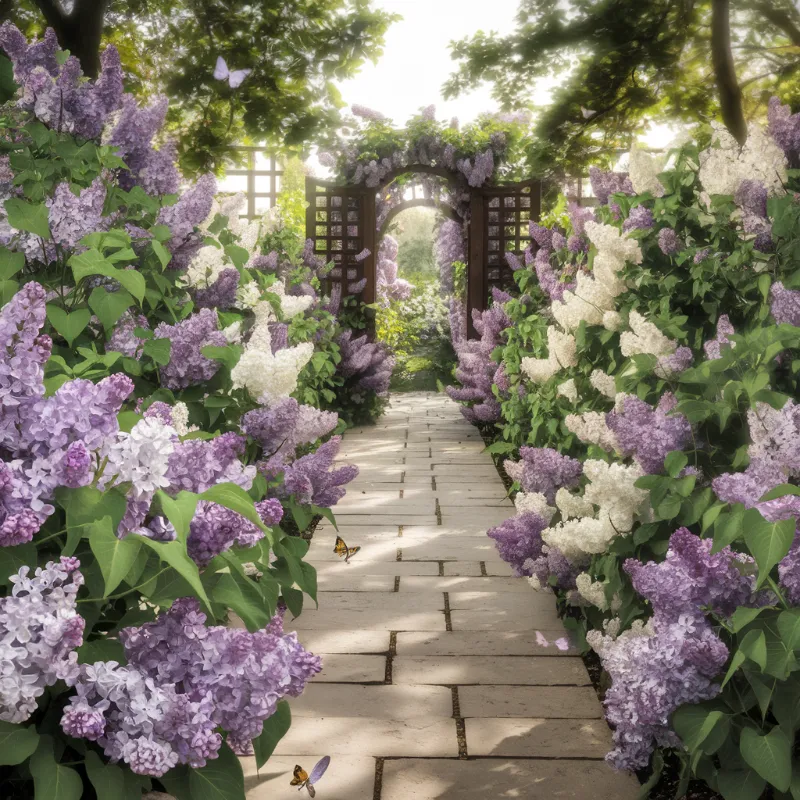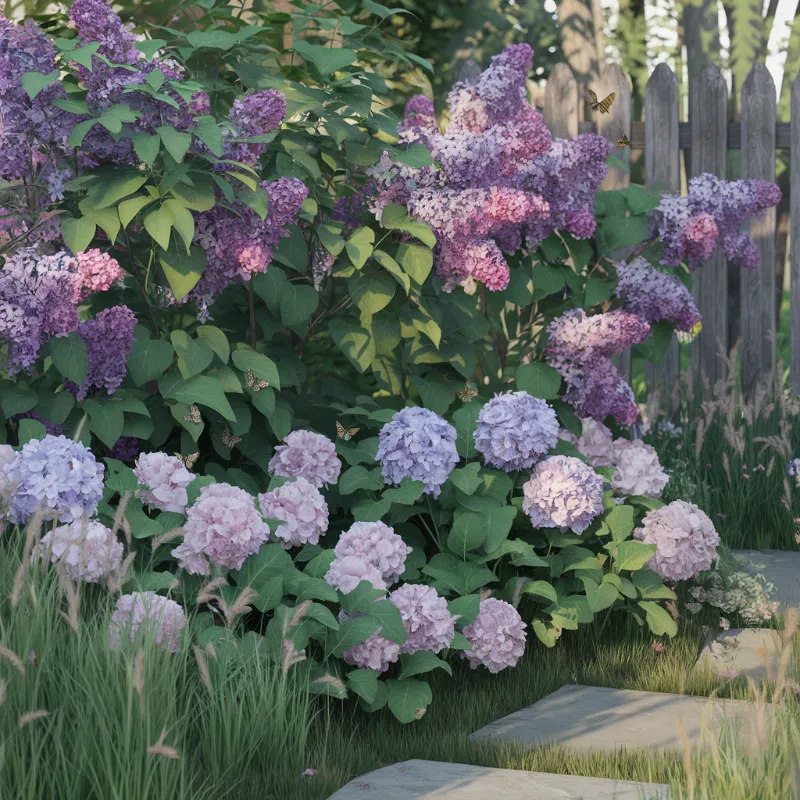Every spring, my grandmother’s garden turned into a magical place. The lilac bushes near her farmhouse fence were more than plants. They were storytellers of seasons past, filling the air with a sweet fragrance that made childhood memories unforgettable.
Lilac landscaping ideas are more than just decoration. These versatile shrubs can transform outdoor spaces. They come in compact sizes and tall varieties, adding beauty and function to any garden.
To use lilacs well, you need to know about their growth. They can grow from 4 to 15 feet tall. This makes them great for creating privacy, focal points, or border gardens.
Lilacs thrive in zones 3 through 7. They grow strong roots in 2 to 3 years. They need full sun and slightly alkaline soil to bloom beautifully.
Lilacs are perfect for any garden, big or small. Their short but stunning blooming period turns gardens into colorful and fragrant displays. They attract butterflies and create unforgettable moments.
Let’s discover the landscape uses for a lilac !
Table of Contents
Understanding Lilac’s Role in Modern Landscaping
Lilacs have become more than just garden plants. They are now key elements in modern landscaping. These beautiful shrubs add beauty and new ideas to outdoor spaces.
Traditional vs Contemporary Lilac Applications
Planting lilacs has changed a lot. Today, landscapers use them in many creative ways. They choose compact and reblooming varieties for different garden styles.
- Compact varieties for small urban gardens
- Architectural focal points in modern landscapes
- Sustainable, low-maintenance landscaping solutions
Year-round Visual Impact in Garden Design
Low-maintenance lilac landscaping focuses on year-round beauty. These plants have interesting foliage and structure all seasons.
| Season | Lilac Characteristic |
|---|---|
| Spring | Dramatic flowering |
| Summer | Dense green foliage |
| Fall | Attractive leaf color changes |
| Winter | Architectural branch structure |
Climate Considerations for Lilac Success
Knowing your local climate is key for growing lilacs. These hardy shrubs grow well in USDA Hardiness Zones 3-8. Each variety is suited to different conditions.
“Choose lilac varieties that match your local climate for optimal growth and performance.”
By picking the right lilac varieties and planting them wisely, gardeners can create beautiful, lasting landscapes. These landscapes celebrate the beauty of lilacs.
Creating Privacy Screens and Natural Boundaries

Lilac hedges are a great choice for gardeners wanting beauty and function. These shrubs turn ordinary property lines into beautiful green barriers. They offer privacy and add visual appeal.
Designing a lilac hedge needs careful planning. Choosing the right varieties and placing them correctly is key. This creates a natural boundary that works well.
- Select taller lilac varieties like Common lilac (Syringa vulgaris)
- Plant bushes 3-4 feet apart for dense coverage
- Choose locations with full sun exposure
- Ensure well-draining soil conditions
Different lilac varieties have unique traits for privacy. Some grow fast, while others are more compact.
| Lilac Variety | Height | Screening Ability |
|---|---|---|
| Common Lilac | 10-15 feet | Excellent |
| Dwarf Lilac | 4-6 feet | Good for Small Spaces |
| Japanese Tree Lilac | 15-20 feet | Superior Coverage |
Creating a successful lilac hedge means knowing how they grow and how to care for them. Proper spacing between plants allows air to circulate and promotes healthy growth. Gardeners should plan for a full hedge in five years with the right planting techniques.
A well-designed lilac hedge transforms outdoor spaces, adding beauty and privacy.
Mixing lilac varieties with other shrubs can make the screen more effective and interesting. Adding different heights and textures creates a dynamic, layered boundary. This goes beyond traditional landscaping.
Landscape Uses for Lilac in Mixed Border Gardens
Creating a stunning lilac border needs careful planning and the right plants. Lilac garden design lets gardeners make lively and beautiful spaces.
Companion Plants for Lilac Borders
Choosing the right plants can make a lilac border amazing. Here are some great options:
- Hydrangeas with soft white blooms
- Roses for contrasting textures
- Peonies that bloom alongside lilacs
- Ornamental grasses for structural interest
Seasonal Color Combinations
Lilacs add beauty all year, not just in spring. Planting smartly keeps your garden looking good all season.
| Season | Complementary Plants | Color Palette |
|---|---|---|
| Spring | Tulips, Daffodils | Pastel yellows, whites |
| Summer | Black-eyed Susans | Deep purples, yellows |
| Fall | Chrysanthemums | Rich burgundies, oranges |

Height and Depth Planning
Good lilac border design means thinking about plant heights and where to put them. Here’s how:
- Put taller lilacs at the back
- Use dwarf lilacs like ‘Miss Kim’ up front
- Make heights go up and down for depth
- Space lilac shrubs 12 feet apart for best growth
*”A well-designed garden is a living canvas, where each plant tells a story of color, texture, and harmony.”*
Designing Statement Focal Points with Solo Lilacs
Adding a single lilac to your garden can make a big difference. Lilac landscaping ideas let you make a bold statement with just one shrub. These plants can be the main attraction, with their beautiful flowers and sweet scent.
When picking a solo lilac for a focal point, think about a few things:
- Mature size and growth habit
- Bloom color and timing
- Surrounding landscape design
- Sunlight and soil conditions
“A single well-placed lilac can become the crown jewel of your garden landscape”
Where you place your lilac is key to its impact. Put it where it can be seen from different spots, like near a patio or along a path. Or make it a standout in an open area.
| Lilac Variety | Height | Bloom Color | Best Placement |
|---|---|---|---|
| Common Lilac | 10-15 feet | Purple, White | Large open spaces |
| Dwarf Korean Lilac | 4-6 feet | Lavender | Small gardens, borders |
| Preston Lilac | 8-12 feet | Pink, Magenta | Mixed borders |
To make your solo lilac stand out more, add some plants around it. Use low-growing perennials or ornamental grasses. They’ll make a nice base that shows off the lilac’s beauty.
Small Space Solutions with Dwarf Lilac Varieties
Gardeners with small outdoor spaces can enjoy lilacs. Dwarf lilac varieties are perfect for urban gardens, small patios, and tight spaces.
Choosing the right dwarf lilacs is key for small gardens. They can turn tiny areas into lively, scented spots without taking up too much room.
Container Growing Options
Container gardening makes lilac care easy. Dwarf lilacs do well in big pots, adding beauty to patios and balconies.
- Select containers at least 18 inches deep for optimal root development
- Use well-draining potting mix specific to flowering shrubs
- Choose pots with drainage holes to prevent root rot
Urban Garden Applications
Dwarf lilacs are great for city gardens. The Dwarf Korean lilac (Syringa meyeri ‘Palibin’) is a top pick for small areas.
| Variety | Height | Width | Growing Zones |
|---|---|---|---|
| Dwarf Korean Lilac | 4-6 feet | 5-7 feet | USDA 3-7 |
Space-saving Pruning Techniques
Pruning is key for keeping dwarf lilacs small. Remove spent blooms and trim lightly after they flower. This encourages growth and keeps the shape right.
“In small gardens, a single dwarf lilac can create visual interest without consuming excessive space.”
By picking the right dwarf varieties and using smart gardening tips, even the smallest areas can be filled with lilac beauty and scent.
Creating Fragrant Garden Walkways and Entrances
Transforming garden pathways into sensory experiences requires strategic planning with lilacs. A fragrant lilac garden can turn ordinary walkways into extraordinary journeys of botanical delight. The key lies in understanding how to leverage these aromatic plants for maximum landscape impact.
Lilac garden design offers multiple approaches to creating enchanting entrance experiences. Strategic placement allows gardeners to craft immersive sensory environments that welcome visitors with remarkable fragrance.
Scent Mapping for Maximum Impact
Developing an effective scent map involves careful consideration of landscape uses for a lilac. Consider these strategic placement techniques:
- Position lilacs near walkway edges to create natural fragrance corridors
- Plant varieties with complementary bloom times for extended aromatic experiences
- Select wind-oriented locations to maximize scent distribution
Strategic Placement Tips
Optimal lilac placement requires understanding plant characteristics and garden dynamics:
| Lilac Variety | Height | Recommended Spacing | Growing Zones |
|---|---|---|---|
| Minuet | 6-8 feet | 5 feet | 3-9 |
| James MacFarlane | 6-8 feet | 5 feet | 2-7 |
| White Lilac | 6-8 feet | 3-5 feet | 3-7 |
For smaller spaces, consider container gardening with dwarf varieties. Large decorative containers measuring 18-24 inches provide excellent growing environments for compact lilac specimens.
The magic of a fragrant garden walkway lies not just in planting, but in creating a sensory journey that delights and surprises.
When designing walkways, maintain a pathway width of 3-4 feet to ensure comfortable walking while allowing lilacs sufficient space to grow and release their intoxicating fragrance.
Frequently Asked Questions
What are lilac plants good for?
Lilacs are great for adding color, fragrance, and charm to a garden. They attract pollinators like butterflies and bees, making them beneficial for the ecosystem. Their dense growth also provides privacy and wind protection when used as hedges. Plus, their blooms can be cut for stunning floral arrangements.
What is the old wives’ tale about lilacs?
One old belief is that planting lilacs near your home brings protection and good luck. In Victorian times, lilacs symbolized lost love and were sometimes planted near graves. Another superstition says that bringing lilacs indoors is bad luck because their strong scent was thought to be overwhelming and associated with spirits.
Can lilacs be used as a hedge?
Yes! Lilacs make fantastic hedges because they grow thick, tall, and wide. They offer privacy, block wind, and create a natural border for yards. Just keep in mind they lose their leaves in winter, so they won’t provide year-round coverage like evergreen hedges.
What can you do with lilac bushes?
Trim them for shape – Keeps them healthy and looking neat.
Use cut flowers – Fresh lilac blooms smell amazing indoors.
Make lilac-infused products – Lilac syrup, tea, or scented oils.
Divide and replant – If they get too big, you can propagate new bushes.
How do you use lilacs in landscaping?
Lilacs work beautifully as:
Privacy hedges – Lush and fragrant when in bloom.
Focal points – A single lilac bush can stand out in a garden.
Border plants – Lines driveways or fences with color and scent.
Companion planting – Pairs well with roses, peonies, and hydrangeas.
What are the cons of lilac bushes?
Short bloom time – They only flower for a few weeks in spring.
Can be invasive – Some types spread aggressively through suckers.
Needs pruning – Without regular trimming, they get leggy and overgrown.
Attracts pests – Lilacs can suffer from powdery mildew, aphids, and borers.
Deciduous – They lose leaves in winter, leaving bare branches.

